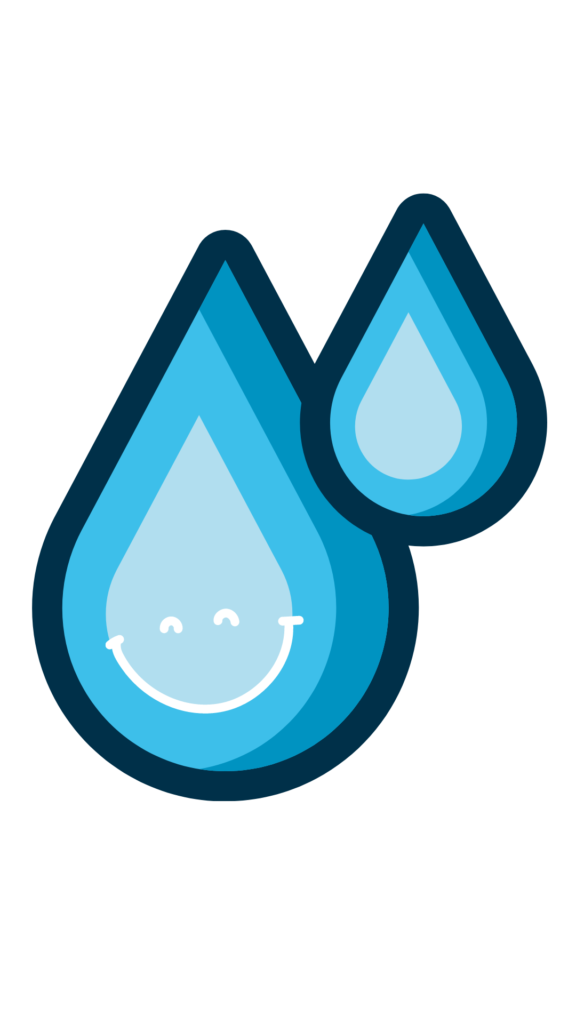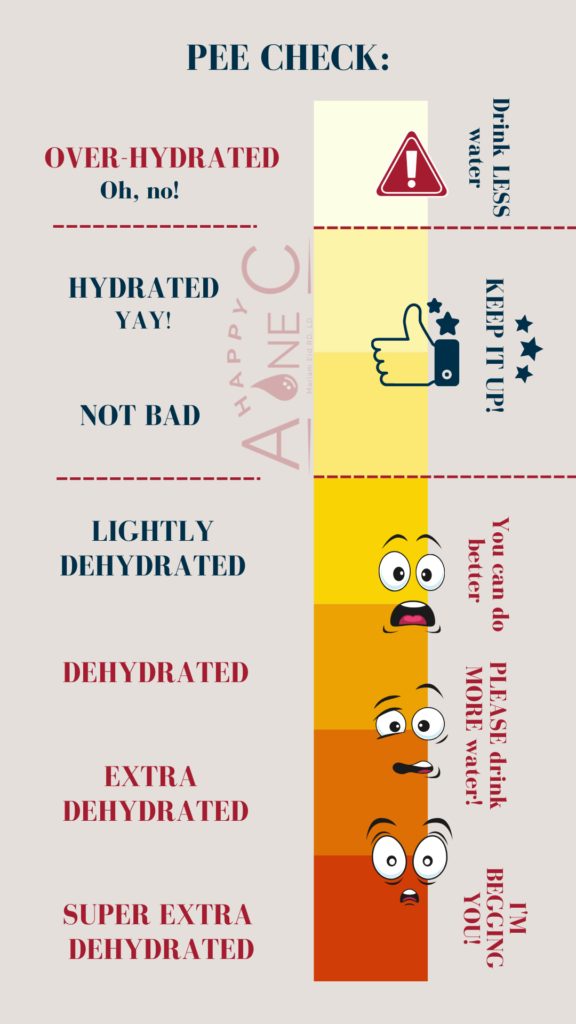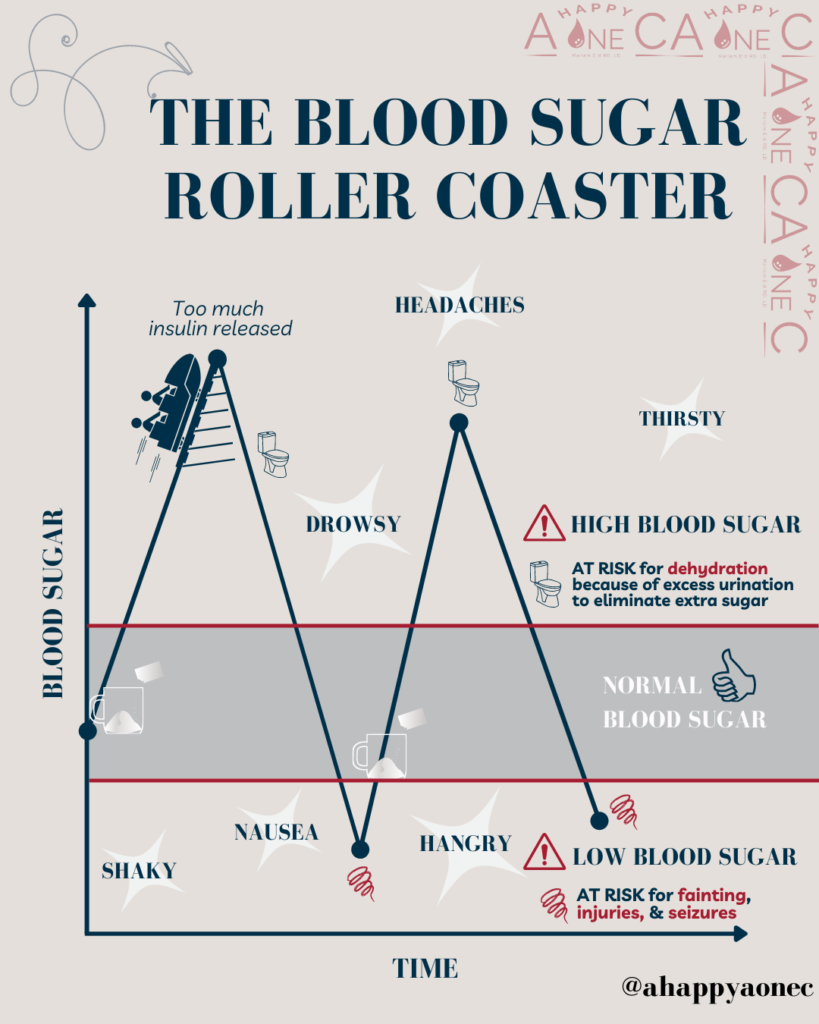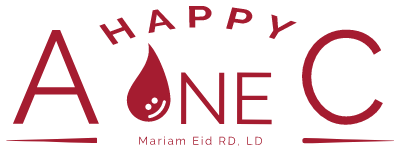Humans are made up of cells floating around in water.
Just as every person has unique calorie needs, we all have unique fluid needs. Our fluids needs depend on our calorie needs.The more calories your body needs, the more water your body will need to digest and metabolize the food. It probably comes at no surprise to you that we should aim to have water as our primary fluid. Water also makes up 90% of our blood. That’s why when you get your lab work done, the healthcare team will often recommend that you drink water before they take blood.
Dehydration & Prediabetes
You may have noticed more recent field trips to the bathroom after your prediabetes diagnosis. This is especially why people with prediabetes are at higher risk for dehydration and require paying closer attention to hydration status.
dehydration = higher a1c
We mentioned water makes up 90% of our blood. Dehydration decreases the amount of water in the blood. Therefore there is more sugar relative to water in the blood. It’s basically a game of perception because the ratio of water to sugar in the blood is off. The sugars are simply more concentrated in your blood. It might look like you have more sugars in the blood but there may really just be less water than normal so by default, it appears like there’s more sugar. This high reading can usually be corrected by drinking enough water to rehydrate your blood.
Basically, poor hydration status may be falsely elevating your blood sugar and A1C. Explore this article to learn other factors that interfere with an accurate A1C reading.
cycle of dehydration
Even mild dehydration can wreak havoc on your blood sugar levels in a dangerous cycle. The less water present to hydrate the blood, the more concentrated the sugar is and the more likely you will have a high blood sugar reading. Your super smart body responds to high blood sugar by signaling the the kidneys to send you to the bathroom to flush out excess sugar from the body (PMID: 21994426). The more you pee, the more dehydrated you become, and the cycle continues. If you were already dehydrated beforehand, this compensatory urination makes matters worse. On top of that, dehydration is a mild form of stress. Like every other form of stress, your body responds by increasing cortisol to increase blood sugar, which worsens insulin resistance.
Dehydration symptoms
- Muscle cramps, headaches
- Dizziness
- Dry lips or nose
- Fatigue
- Smelly and dark yellow urine
- Constipation
- Extra thirsty
- Extra bathroom trips
THINGS THAT INCREASE YOUR FLUID NEEDS
- Exercise
- Diarrhea
- Vomitting
- Increasing fiber intake
- Increasing overall food intake
- Excessive sweating (hot days)
Why exactly do we need water?
Since water makes up 50–65% of our bodies, every single metabolic function depends on the constant availability of water. Metabolism is a fancy word for all the chemical reactions that go on in the body to give us energy from food. One of the first symptoms people who drink more water will notice is an instant boost in energy and less reliance on caffeine. This makes sense since water involved in the last step of energy production. Therefore, if we aren’t drinking enough water, our energy levels will be the first to feel it.
You probably know water is good for you but maybe you don’t have enough concrete motivators to get you to drink more. Here are some:
- Water is an is the internal moisturizer. Hence, why its good for your skin
- Water helps you poop by eliminating waste from metabolism
- Water controls your body temperature
- Water breaks down the food we eat to give us energy
- Water plays an important role in blood sugar balance
- Water makes saliva. which helps you taste and enjoy your food.
- Water makes up 90% of your blood.

Are you getting enough water?
The best way to check if you’re getting enough fluids is to take a closer look at your pee. Just like everything else in life, we all have to find our personal balance with our water intake. We don’t want to drink too much water and we don’t want to drink too little water. We need a happy medium. You may have heard the suggestion of drinking a gallon of water per day; however, for some people that’s simply way too much. If you remember back to your biology class, perhaps you’ll recall learning about the deadly effect of hypotonic solutions. When too much water floods your body at once, the cells become hypotonic and burst like a balloon. This is referred to as water intoxication. So where should we start with our water intake?
According to the Academy of Nutrition and Dietetics, the average non-active adult needs between 9-12 (8 oz.) cups per day. If that sounds like too much to you that’s totally OK. It’s hard to get used to drinking that much water and going to the bathroom frequently. The cool thing is that we can get some of fluid intake from water-rich foods. This means that we should aim to drink about 7-10 glasses of water per day.
What are electrolytes?
The article above suggests that the average person takes in about 20% of their fluids from foods naturally rich in water, such as fruits and vegetables. This is an important part of your hydration status because they also contain electrolytes. Your electrolyte intake contributes to your hydration status.
Electrolytes are minerals that do so much for us. They control the flow of water into and out of our cells, contractions of our muscles, and blood pressure. Electrolytes are lost in your sweat, which is why athletes usually supplement with Gatorade. Most people can get enough electrolytes from fruits and vegetables and don’t need an additional supplement.

Liquid sugar
When we think of sugar and liquids, we want to think about how they influence our blood sugar levels. We mentioned in a previous article that sugar from carbs hold the strongest ability to increase your blood sugar levels. Liquids are generally digested much more quickly than solid food.
Since we are VERY efficient at digesting sugar quickly, when we ingest sugars in the form of a liquid, the sugars fly through the digestive tract. As the sugars are digested and enter the blood stream, the floodgates are unleashed and your blood sugar spikes. This is especially true if you drink sugar on an empty stomach since there is no fiber, fat, or protein to slow down the digestion of sugar.
Your blood sugar and insulin levels overshoot leading to a steep rise in blood sugar. Leftover insulin leads to the pleasantries of a blood sugar crash. The recurring spike and dip in blood sugar is what characterizes a blood sugar rollercoaster.
Liquid sugars are found in sugar-sweetened drinks, such as sports drinks, slushees, energy drinks, sweetened coffee, soda, sweet tea, and fruit juices. This can be lifesaving if we need a quick burst of energy (like athletes), or if our blood sugar levels are dangerously low and we need to quickly increase them.
Fruit and vegetables juices, such as orange juice and apple juice, have a similar effect as sugar-sweetened drinks. You’re probably thinking that they’re fruits and fruits contain fiber. When fruits are processed down to fruit juices, a majority of their nutrients, including the fiber, are stripped and the sugars remain. These sugars acts identically to the liquid sugar outlined above in the blood stream.

The blood sugar roller coaster depicted above parallels the intimidating roller coasters you’ve seen at amusement parks with a sky-high incline followed by a sinking drop.
Adjusting Your Fluid intake
Now that you’ve learned about how your body responds to liquid sugar, it’s important to now how to approach them in such a way that supports your health & satisfies you. Start by analyzing level of importance these drinks have in our lives. Before thinking of reducing your intake of sugary drinks, start simply with making sure you drink enough water.
First and foremost, it’s best practices to disperse your water intake throughout the day instead of drinking it all within a certain time frame. The body can only tolerate efficiently absorbing no more than 16 oz. (2 cups) of water at a time. Aim to drink water between meals. Drinking too much water before a meal can lead to premature fullness and prevent you from getting enough nutrients in at that meal.
The best place to start with water intake is where you’re at. So if your typical day includes one 16-ounce bottle of water then start by adding only one more. Write yourself a calendar reminder to check in with your progress every week.
- Can you realistically add a third water bottle to your routine?
- How’s your pee looking? Refer to the chart above.
- Have you noticed any changes in appetite or energy levels?
- Can you balance your daily activities with your bathroom field trips?
Fun ways to increase your water intake
- Consider adding a small (8 oz.) bottle of water with every can of soda you drink.
- Add an herbal cup of tea to your nighttime routine
- Include more broth-based soups in your meal schedule.
- Add a water enhancer to your water.
- If you only like cold water, carry an insulated water bottle with you.
- Explore flavoring your water with lemon slices, cucumber slices, mint, and fresh or frozen fruits (esp. berries)!
- Sparkling water with raspberries with a sprig of mint.
- Download an app for helpful water reminders
- Add more water-rich foods into your meals, such as cucumbers, tomatoes, bell peppers, celery.
Tweaking liquid sugar intake
You don’t have to go cold-turkey. You have options. The good news is that there are carbonated alternatives available with different artificial sweeteners that don’t have a spiking effect on your blood sugar. There are conflicting opinions about artificial sweeteners, but the general consensus is that they’re more gentle on your blood sugar in the long tun. It can take some time to figure out which artificial sweetener is the most palatable and best tolerated by your digestive system. But the journey is worth it and your blood sugar will thank you in the long run. You’ll find some of my favorite recommendations here.
If you choose to experiment with drinks sweetened with sugar substitutes, please note they are known to cause diarrhea and stomach pain. This happens more frequently with alternative sweeteners such as Sucralose (Splenda), mannitol, sorbitol. Every person has a unique thresholds to these sugar substitutes so I encourage you to explore your personal tolerance. If you experience symptoms, I suggest trying stevia-sweetened drinks, such as Zevia, or other carbonated drinks that are flavored without alternative sweetness, such as Bubbly. You can find a full list here.
The tapering method
If you can’t imagine life without your sweet tea or Dr Pepper, I encourage you to use the tapering method. The tapering method is revolves around slowly tweaking the sugar content in your drinks to experiment with your sugar tolerance. This method helps your taste buds adjust to the decrease in sugar that you are able to maintain this change in the long run.
Start by identifying what your typical routine is with sugar sweetened beverages. We’ll use sweet tea as an example. Let’s say you’re used to drinking 8 ounces of sweet tea at every meal. Start by drinking 7 ounces of your regular sweet tea and 1 ounce unsweetened sweet tea in the mix. Ask yourself:
- How did that taste?
- Can I seriously enjoy this?
- Does this feel like something I can stick to?
Remain consistent with your change and check in with yourself every week. Move towards 6 ounces of sweet tea to 2 ounces of unsweetened sweet tea and continue until you find your balance. Overtime you may notice that your taste buds start to enjoy and tolerate less sugar.
This process takes time and you might find your perfect balance to be 4 ounces of the sugar sweetened option to 4 ounces of the unsweetened option. You can apply do the exact same method with Coca-Cola or Dr Pepper by the “diet”/sugar-free version or regular unsweetened carbonated water as the unsweetened counterpart.
Diuretics:
Alcohol, caffeine, and sugar-sweetened beverages have been thought to be dehydrating due to their diuretic properties. Diuretics promote the loss of bodily fluids via urine. Despite their diuretic effects, the research suggests that caffeinated beverages, such as coffee and tea, consumed in moderate quantities are not dehydrating. Although the diuretic effects of caffeine may not play a significant role in dehydration, caffeinated drinks typically displace water intake.
Alcohol
If you’re of legal age and consumed alcohol in the past, you may have noticed that it makes you pee more. That’s actually backed by science. Alcohol blocks the hormone that saves water, vasopressin, thereby irresponsibly wasting your precious water reserves.
Alcohol also increases your risk of dipping your blood sugar if consumed on an empty stomach. It interferes with your livers ability to keep your blood sugar levels happy.
If you’re above 21 years old and choose to drink alcohol, make sure you’ve eaten within 2 hours and add an extra cup of water to your soon after to replace any lost fluid.
CAFFIENE
The Food and Drug Administration’s caffeine recommendation for adults (over 18) is consuming fewer than 400 mg of caffeine per day, which is estimated to be about four to five 8-ounce coffee cups. For people aged 12-18, the American Academy of Pediatrics (AAP) recommends consuming no more than 100 mg of caffeine per day, which is about one 8-ounce cup of coffee.
Listen, coffee is great. It’s my personal favorite drink. Despite how delicious and satisfying a drink is, a beverage should NEVER replace a meal. Many people skip meals and hold themselves over with their favorite Starbucks latte. It’s the culture of our time. However, I’m here to tell you, that you need more than an iced caramel macchiato to nourish your body. So long as you enjoy it with or after a meal, I dont want to interfere with your coffee.
Energy drinks: double whammy
Energy drinks can also increase the risk of dehydration, possibly because of their caffeine and sugar content. Studies have shown that dehydration and extra bathroom trips are the most common side effects of energy drinks (PMID: 33211984). Energy drinks are also linked with a 20-30% increase in insulin and glucose levels, which can make blood sugar control even more difficult.
The content of caffeine in energy drinks ranges from 80-200 mg. Therefore, the average content of caffeine in energy drinks is 140 mg, which is 40 mg above the AAP’s caffeine recommendations. I encourage you to read the nutrition label to identify their caffeine content such that you remain under the FDA’s caffeine recommendation. You can see how easy it becomes to over consume caffeine with energy drinks. One regular can is above a teenagers safe caffeine limit while two cans hovers on the edge of an adult’s safe limit. This is serious because too much caffeine intake can cause irregular heartbeats, heart failure, dehydration, anxiety, jitteriness, and sleep disruption.
I highly encourage you to transition away from energy drinks. Energy drinks create a cycle of false sense of dependency on them. They disrupt your sleep and convince you to rely on them to energize you through your fatigue. The APP established that energy drinks have no place in the intake of teenagers.
The first area in your diet to consider after a prediabetes diagnosis is your fluid intake. Start by ensuring you’re drinking enough water and take small steps thereafter. Flavor your water to make it more enjoyable. If you’re struggling with soda intake, try the tapering method. Enjoy the pleasures of diuretics but make ensure they’re not severely displacing your water intake. Make it a habit to enjoy them with a meal instead of drinking them on an empty stomach. Don’t forget to check out our ‘Drink Recs‘ page to help you adjust your fluid intake in the easiest way possible.
Remember, prediabetes reversal is a lifelong journey. You are in the process of building habits that you’ll take into your later years — habits that have the power to change the trajectory of your health and well-being.
